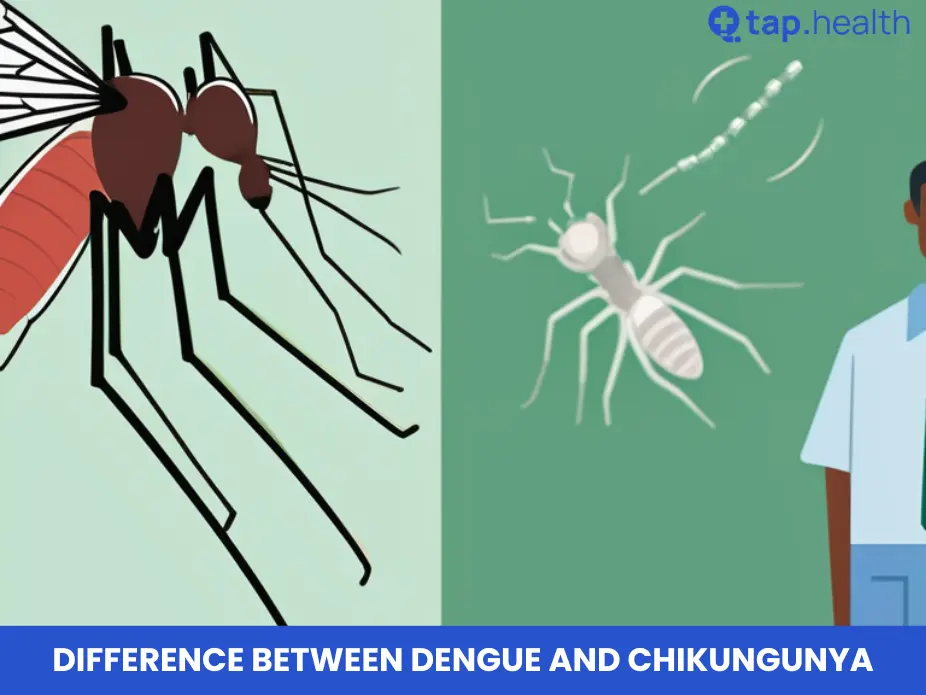Dengue and Chikungunya are two mosquito-borne viral infections that often lead to confusion due to their overlapping symptoms. Both diseases are primarily transmitted by the Aedes mosquitoes, predominantly in tropical and subtropical regions. Despite their similarities, Dengue and Chikungunya are caused by different viruses and present unique clinical features. This detailed guide will explore the history, symptoms, diagnosis, treatment, complications, and preventive measures associated with both diseases, emphasizing their differences and similarities.
Historical Background and Origins
Dengue Fever:
- Historical Emergence: Dengue fever has been recognized for over two centuries. The earliest records of Dengue-like symptoms date back to the 18th century in Asia, Africa, and North America. However, it became a significant global health issue in the mid-20th century, particularly after World War II. Rapid urbanization, increased global travel, and ineffective mosquito control measures contributed to its spread.
- Virus Family: Dengue fever is caused by the Dengue virus (DENV), a member of the Flaviviridae family. There are four closely related serotypes of the Dengue virus (DENV-1, DENV-2, DENV-3, and DENV-4). Infection with one serotype provides lifelong immunity to that specific serotype but not to the others, making sequential infections possible and sometimes more severe.
Chikungunya:
- Historical Emergence: Chikungunya was first identified during an outbreak in 1952-1953 on the Makonde Plateau, which borders Tanzania and Mozambique. The name “Chikungunya” comes from the Makonde language and means “that which bends up,” describing the stooped posture of sufferers due to severe joint pain.
- Virus Family: Chikungunya is caused by the Chikungunya virus (CHIKV), which belongs to the Togaviridae family, specifically the Alphavirus genus. Unlike Dengue, there is only one serotype of the Chikungunya virus, although mutations in the virus can affect its transmissibility and severity.
Geographical Distribution
Dengue:
- Endemic Regions: Dengue is endemic in more than 100 countries, particularly in Southeast Asia, the Western Pacific, the Americas, and Africa. The World Health Organization (WHO) estimates that around 50-100 million Dengue infections occur annually, with a significant number of cases requiring hospitalization.
- Seasonal Variations: The incidence of Dengue fever peaks during the rainy season when mosquito breeding sites proliferate. Urban areas with poor water drainage and sanitation are particularly vulnerable.
Chikungunya:
- Endemic Regions: Chikungunya was initially confined to Africa and Asia but has since spread to Europe, the Americas, and the Caribbean. The virus’s spread has been facilitated by the adaptability of its mosquito vectors (Aedes aegypti and Aedes albopictus), which thrive in a wide range of climates.
- Outbreaks: Chikungunya outbreaks tend to be sporadic but can affect large populations rapidly. The most significant outbreaks have occurred in India, Southeast Asia, the Indian Ocean Islands, and the Caribbean.
Transmission: The Role of Mosquito Vectors
Both Dengue and Chikungunya are transmitted by the bite of infected Aedes mosquitoes, primarily Aedes aegypti and Aedes albopictus. These mosquitoes are aggressive daytime biters, with peak activity in the early morning and late afternoon. They breed in stagnant water sources, such as containers, tires, and clogged drains.
Differences in Transmission:
- Aedes aegypti: This species is the primary vector for both Dengue and Chikungunya. It is well adapted to urban environments and often breeds close to human habitation. It has a preference for biting humans over animals.
- Aedes albopictus: Also known as the Asian tiger mosquito, this species is a secondary vector but is more adaptable to cooler climates, which has allowed it to spread to more temperate regions. It can also transmit both viruses, but its role is more prominent in Chikungunya outbreaks.
Symptomatology: Overlapping Yet Distinct
While Dengue and Chikungunya share several symptoms, there are crucial differences in their presentation:
Dengue Symptoms:
Here are the symptoms of dengue–
- Fever: Sudden onset of high fever (up to 104°F or 40°C) that can last 2-7 days.
- Headache: Severe headache, often described as intense pain behind the eyes (retro-orbital pain).
- Rash: A rash may appear 2-5 days after the onset of fever, initially presenting as flushed skin or small red spots (petechiae) that can spread across the body. In some cases, a second rash may occur after the fever subsides, presenting as a measles-like rash.
- Joint and Muscle Pain: Severe muscle and joint pain, often described as “bone-breaking” pain, is common. However, joint pain is generally less intense and shorter-lasting compared to Chikungunya.
- Mild Bleeding: Symptoms may include mild bleeding manifestations such as nosebleeds, gum bleeding, or easy bruising, often due to a drop in platelet count.
- Nausea and Vomiting: Gastrointestinal symptoms such as nausea, vomiting, and abdominal pain may occur.
- Fatigue and Weakness: Prolonged fatigue and general malaise can persist even after other symptoms have subsided.
- Severe Dengue (Dengue Hemorrhagic Fever/Dengue Shock Syndrome): In severe cases, patients may develop plasma leakage, severe bleeding, organ impairment, and shock, which can be life-threatening.
Chikungunya Symptoms:
- Fever: Similar to Dengue, Chikungunya starts with a sudden high fever, often accompanied by chills.
- Severe Joint Pain: The hallmark of Chikungunya is severe joint pain (arthralgia), particularly in the wrists, knees, ankles, and fingers. This pain can be debilitating, causing patients to adopt a stooped posture. Joint pain can persist for months or even years, resembling chronic arthritis.
- Rash: A maculopapular rash (flat, red area covered with small bumps) may develop within 3-7 days of fever onset. The rash is more widespread than in Dengue, often affecting the face, trunk, limbs, and extremities (palms and soles).
- Headache and Muscle Pain: Similar to Dengue, but less severe in intensity.
- Nausea and Vomiting: These symptoms may be present but are less common than in Dengue.
- Fatigue: Prolonged fatigue and weakness, sometimes lasting for weeks.
- Conjunctivitis: Mild conjunctivitis (redness of the eyes) may occur in some cases.
- Persistent Joint Pain: Unlike Dengue, where joint pain is typically short-lived, Chikungunya can lead to chronic joint pain that mimics rheumatoid arthritis, significantly impacting quality of life.
Detailed Differences Between Dengue and Chikungunya
Here’s a detailed comparison between Dengue and Chikungunya presented in a table format:
| Aspect | Dengue | Chikungunya |
| Causative Agent | Dengue virus (Flavivirus) – 4 serotypes | Chikungunya virus (Togavirus) – 1 type |
| Incubation Period | 3-7 days | 1-12 days |
| Duration of Symptoms | 4-7 days; severe cases may last longer | 1-2 weeks; joint pain can persist for months |
| Initial Symptoms | High fever, severe headache, pain behind eyes | Sudden high fever, severe joint pain, muscle pain |
| Joint Pain | Present but less severe | Severe and debilitating, often long-lasting |
| Rashes | Confined to limbs and face | Widespread; affects face, palms, feet, and limbs |
| Complications | Dengue Hemorrhagic Fever (DHF), Dengue Shock Syndrome (DSS), respiratory problems | Chronic arthritis, rare neurological issues |
| Platelet Count | Often significantly reduced | Typically normal or slightly affected |
| Fever Duration | Usually lasts 4-7 days; may be biphasic | Typically lasts 1-2 weeks |
| Headache | Severe, often behind eyes | Less severe compared to Dengue |
| Muscle Pain | Present, but usually less intense | Severe and often debilitating |
| Fatigue | Present but usually resolves with fever | Common and can persist long after acute phase |
| Swelling | Less common | Significant joint swelling |
| Bleeding Tendency | Common in severe cases (e.g., gum bleeding, bruising) | Rare |
| Neurological Complications | Rare, but possible in severe cases | Rare, but can include encephalitis or neuropathy |
| Chronic Symptoms | Uncommon; most recover completely | Chronic joint pain and arthritis possible |
| Diagnostic Tests | Serological tests for Dengue-specific antibodies, Dengue virus antigens, or PCR | Serological tests for Chikungunya-specific antibodies or viral RNA |
| Treatment Focus | Supportive care, hydration, monitoring platelet counts | Symptom relief with NSAIDs, supportive care |
| Preventive Measures | Mosquito control, use of repellents, eliminating breeding sites | Similar to Dengue, with emphasis on mosquito control |
| Geographic Distribution | Tropical and subtropical regions worldwide | Originally Africa, now in tropical and subtropical regions, including parts of Asia and the Americas |
| Historical Impact | Major global health concern for decades | Less well-known until recent outbreaks |
Complications and Severity
Dengue Complications:
- Dengue Hemorrhagic Fever (DHF): Characterized by plasma leakage, bleeding, and thrombocytopenia (low platelet count), DHF can lead to shock and death if not treated promptly. Symptoms include severe abdominal pain, persistent vomiting, rapid breathing, bleeding gums, and blood in vomit or stool.
- Dengue Shock Syndrome (DSS): A severe form of DHF where the patient goes into shock due to severe plasma leakage. It is a medical emergency requiring immediate hospitalization and fluid replacement.
- Organ Involvement: Severe Dengue can lead to liver damage, encephalitis (brain inflammation), myocarditis (heart inflammation), and acute kidney injury.
Chikungunya Complications:
- Chronic Joint Pain: The most significant complication of Chikungunya is chronic arthritis-like joint pain that can last for months or years. This persistent pain can lead to disability and reduced quality of life.
- Neurological Complications: Rarely, Chikungunya can cause neurological issues such as Guillain-Barré syndrome, meningoencephalitis, and optic neuritis.
- Myocarditis: In rare cases, Chikungunya can cause inflammation of the heart muscle, leading to heart complications.
- Severe Cases: Though rare, severe Chikungunya can lead to multi-organ failure and death, especially in older adults or those with underlying health conditions.
Diagnosis: Differentiating the Two Diseases
Clinical Diagnosis:
- Symptom Overlap: Due to the overlapping symptoms, particularly in the early stages, clinical diagnosis can be challenging. Physicians often rely on the patient’s history, including travel to endemic areas, the timing of symptom onset, and the nature of the symptoms.
Laboratory Tests:
- Dengue Diagnosis:
- NS1 Antigen Test: Detects the presence of the Dengue virus’s nonstructural protein 1 (NS1) during the early stages of the infection.
- RT-PCR: Reverse Transcription Polymerase Chain Reaction can detect viral RNA in the blood within the first few days of infection.
- Serology Tests (IgM and IgG): Detects antibodies produced in response to the virus. IgM antibodies typically appear within a week of infection and indicate a recent infection, while IgG antibodies can indicate a past infection.
- Chikungunya Diagnosis:
- RT-PCR: Detects Chikungunya viral RNA during the acute phase of the disease (within the first week).
- Serology Tests (IgM and IgG): Detects antibodies specific to the Chikungunya virus. IgM antibodies appear within days of infection and indicate a recent infection, while IgG antibodies can persist for years, indicating past infection.
- Virus Isolation: In some cases, the virus can be isolated from the blood during the first few days of infection, but this is less commonly performed due to the availability of more rapid diagnostic tests.
Treatment: Symptomatic and Supportive Care
Dengue Treatment:
- No Specific Antiviral: Currently, there is no specific antiviral treatment for Dengue. Management focuses on relieving symptoms and preventing complications.
- Hydration: Oral rehydration therapy or intravenous fluids are essential to prevent dehydration and maintain blood pressure, especially in severe cases.
- Pain Management: Acetaminophen (paracetamol) is recommended for managing fever and pain. Aspirin and nonsteroidal anti-inflammatory drugs (NSAIDs) should be avoided due to the risk of bleeding.
- Monitoring: Patients with severe Dengue require close monitoring for signs of shock, bleeding, and organ impairment. Hospitalization may be necessary for those with severe symptoms.
Chikungunya Treatment:
- No Specific Antiviral: Like Dengue, there is no specific antiviral treatment for Chikungunya. Management is primarily symptomatic.
- Pain Relief: NSAIDs such as ibuprofen and naproxen are commonly used to relieve joint pain and inflammation. Acetaminophen can also be used for fever and mild pain.
- Rest and Hydration: Adequate rest and hydration are crucial during the acute phase of the disease.
- Physical Therapy: For patients with chronic joint pain, physical therapy may be recommended to improve joint function and reduce pain.
Prevention: Reducing the Risk of Mosquito-Borne Diseases
Personal Protection:
- Insect Repellents: Use insect repellents containing DEET, picaridin, or oil of lemon eucalyptus on exposed skin to prevent mosquito bites.
- Protective Clothing: Wear long-sleeved shirts, long pants, socks, and shoes to reduce skin exposure to mosquitoes.
- Mosquito Nets: Use bed nets, particularly in areas with high mosquito populations or where air conditioning is not available.
Environmental Control:
- Eliminating Breeding Sites: Remove standing water from containers, tires, and other potential breeding sites around homes and communities.
- Larvicides: In areas where water cannot be removed, use larvicides to kill mosquito larvae.
- Community Efforts: Community-wide mosquito control programs, including fogging and spraying insecticides, can help reduce mosquito populations.
Vaccination:
- Dengue Vaccine: The Dengue vaccine (Dengvaxia) is available in some countries for individuals aged 9-45 years who have had a previous Dengue infection. It is not recommended for those who have never been infected with Dengue due to the risk of severe disease.
- Chikungunya Vaccine: As of now, there is no licensed vaccine for Chikungunya, although research and clinical trials are ongoing.
FAQ on difference between Dengue and Chikungunya
1. What is the difference between Dengue and Chikungunya?
Answer: Dengue and Chikungunya are both mosquito-borne viral diseases but differ in their symptoms and complications. Dengue is known for high fever, severe headaches, muscle and joint pain, and can lead to severe forms like Dengue Hemorrhagic Fever (DHF) and Dengue Shock Syndrome (DSS). Chikungunya is characterized by severe joint pain that can last for months or years, a rash, and fever. Dengue has multiple serotypes, while Chikungunya has one serotype.
2. How are Dengue and Chikungunya transmitted?
Answer: Both Dengue and Chikungunya are transmitted by Aedes mosquitoes, primarily Aedes aegypti and Aedes albopictus. These mosquitoes breed in stagnant water and are most active during the day.
3. What are the common symptoms of Dengue Fever?
Answer: Common symptoms of Dengue Fever include high fever, severe headaches, retro-orbital pain, muscle and joint pain, rash, and mild bleeding. Severe cases can result in Dengue Hemorrhagic Fever or Dengue Shock Syndrome.
References
- World Health Organization (WHO) – Dengue Fever
WHO Dengue Fever Information - Centers for Disease Control and Prevention (CDC) – Dengue
CDC Dengue Information - World Health Organization (WHO) – Chikungunya
WHO Chikungunya Information - Centers for Disease Control and Prevention (CDC) – Chikungunya
CDC Chikungunya Information - PubMed Central – Chikungunya Virus
PubMed Central Chikungunya Research



